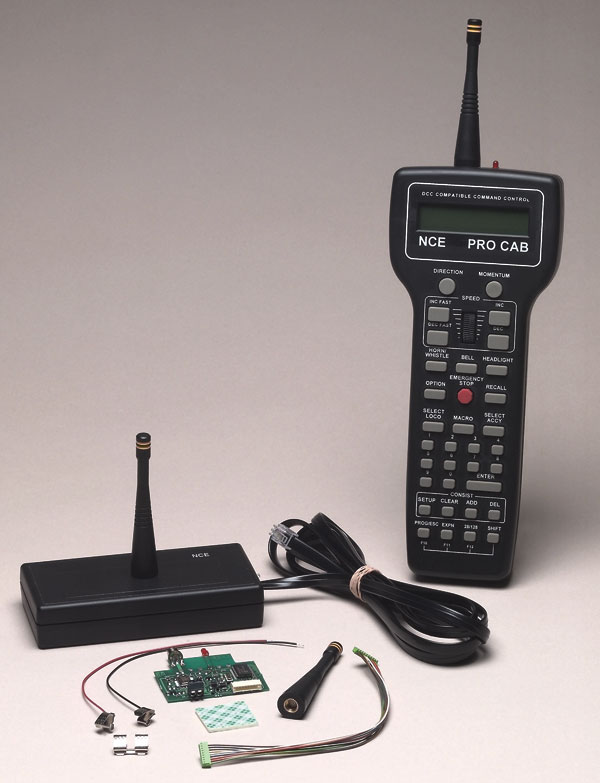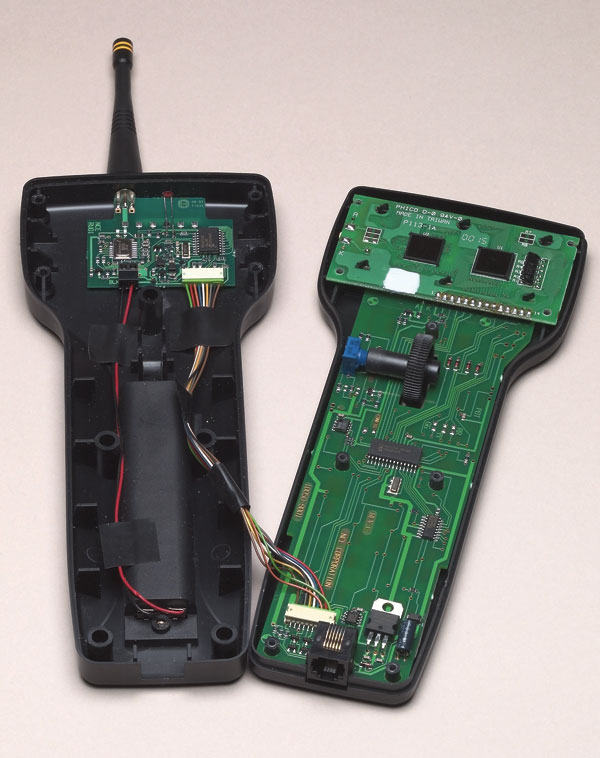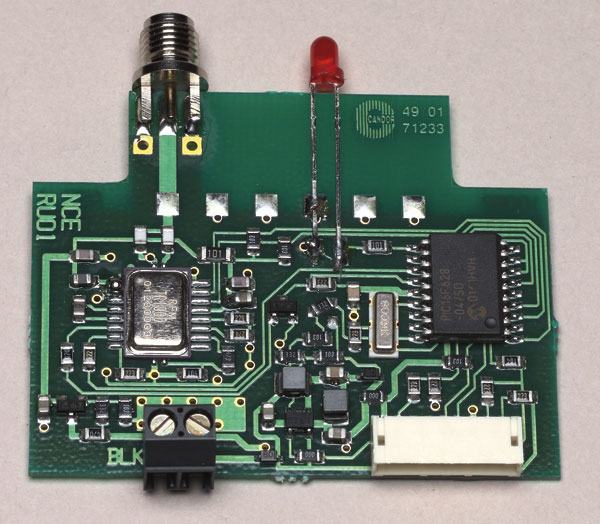For this review I installed NCE’s model RU-Pro wireless adapter kits in a pair of the firm’s ProCab full-featured throttles and added the model RB01 wireless base station to my home layout. The adapter kit was the first NCE wireless option to be released, but the ProCab is now also available with this wireless circuitry already installed. And NCE offers wireless adapters for all three versions of its intermediate cabs.
The heart of the adapter kit is a ready-to-install duplex radio circuit board – “duplex” means it sends and receives on different frequencies at the same time. The kit also includes a cable with plugs to connect the radio circuit to the throttle’s main circuit board, an antenna, battery clips – with wires – that fit in the already molded battery compartment of the ProCab, and a small square of double-stick foam tape to mount the radio board.
To install the kit you must first drill two holes in the plastic throttle case for the antenna mount and the indicator LED, using a template included in the instruction manual. Then it’s a simple matter of inserting the parts and connecting the wires, either with plugs or screw terminals. Soldering isn’t required and I was able to complete each installation in less than 20 minutes. The converted cab requires four AAA batteries for power, and these are not included.
The base station is ready to use and requires only that you screw on its antenna and connect it to the cab bus or command station with the included modular cable. The NCE base station can also be plugged into Wangrow’s SystemOne DCC, and that’s the setup I used for this review.
The wireless instruction manuals do advise that “When performing complex tasks that require many messages to be displayed on the ProCab, communications between the cab and the command station may take longer than expected thus slowing down your programming.” The manual therefore recommends using wireless ProCab in tethered mode – by plugging a cab cable into the original modular socket at the bottom of the cab – for any extensive programming and system setup work.
The range of the radio units is more than adequate in my roughly 40-foot-square basement. I simply set the base station on top of the benchwork next to one wall, not an ideal location. The throttles nevertheless performed correctly in the most distant corners, even on the far side of our furnace room.
One base station can serve as the communication link for as many as 48 wireless cabs, including 16 ProCabs and 32 intermediate cabs, so a single unit will suffice for most model railroads.
Battery life in the wireless cabs is expected to be at least 40 hours with alkaline batteries. The ProCab warning displays give two levels of alert when the batteries run low. Pressing the cab’s emergency stop button once turns the wireless ProCab on; to turn it off press “expn,” then “1.”
Having operated several model railroads with other wireless cabs, I’m convinced this is the best approach for layouts where several operators interact. That’s especially true at yards, where crews tend to congregate as trains arrive and depart. There’s also a practical advantage I cutting way down on the amount of cab bus and the number of plug stations a layout needs.
For those reasons I’m glad to welcome NCE’s wireless cab systems. These are quality products that make it easier to enjoy the best of DCC operation.
Prices:
RU-Pro wireless adapter, $89.95
RB-01 wireless base station, $89.95
ProCab-R full-feature cab with integrated wireless (not reviewed), $239.95
Manufacturer:
NCE Corp.
899 Ridge Rd.
Webster, NY 14580
716-671-0370
www.ncedcc.com
Description:
Ready-to-use electronics for wireless full-feature cab operation with Digital Command Control
Features:
Indicator LEDs for finding best base station location
Solderless installation
System capacity for 16 wireless
ProCabs and 32 wireless intermediate cabs
Tethered mode may be used for programming of if batteries fail
Two-way communication with full throttle displays
Two-level low battery warnings
















